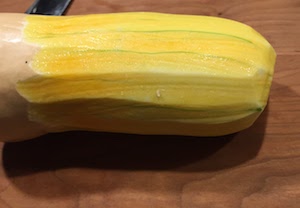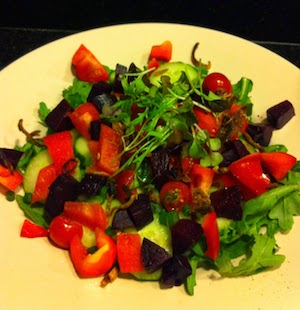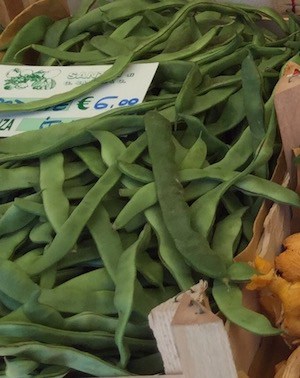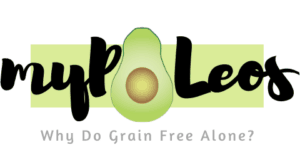
A common question and one that I had 7 years ago when I first started on the Specific Carbohydrate Diet relates to which carbohydrates are allowed on the diet. When talking about the SCD, most guidelines focus on all the grains and starchy foods you need to eliminate from your diet, but it can also be helpful to talk about which higher carb ingredients are allowed on the diet.
What carbs are allowed on the
- Winter Squash (butternut, acorn, etc)
- Onions
- Beets
- Carrots
- Bananas
- Mango
- Pears
- Apples
In addition to those mentioned above, there are a number of other great higher carb SCD legal fruits and vegetables (see tables below for examples and relative carbohydrate amounts). In case you are are in the opposite camp and are attempting to avoid carbs on the SCD, I’ve also included some tips on how to make the specific carbohydrate diet low carb.
SCD Allowed Carbs
High Carb SCD Legal Vegetables
Although you aren’t eating some of the foods you would typically think of a carb heavy on the SCD, like pasta, potatoes
The Specific Carbohydrate Diet has you cut out starchy grains and refined sugar but includes a large number of vegetables and fruits. The carbohydrates in the Specific Carbohydrate Diet primarily come from fruits and vegetables.
As you can see from the table below, some of the highest carb vegetables are fully SCD legal, so if you plan out your diet, it is definitely possible to either include (or exclude) high carb sources in your diet:
| Carbs (g per 100g) | Fiber (g per 100g) | Carbs (g per cup) | |
| Acorn Squash | 15 | 4 | 31 |
| Peas | 15 | 5 | 21 |
| Onions | 10 | 1 | 21 |
| Beets | 10 | 2 | 17 |
| Carrots | 10 | 3 | 13 |
| Butternut Squash | 10 | NA | 22 |
| Spaghetti Squash | 6 | 1 | 9 |
Table: Relative carbohydrate amounts (grams) of several vegetables, per 100g serving and per cup (derived from data at nutritiondata.self.com)
One nice thing you will notice is that unlike pasta and sugary drinks such as soda that are common on a typical western diet high in carbohydrates but also “empty calories”, high carbohydrate foods on the SCD Diet are often very nutritious.
High Carb SCD Legal Fruit
In addition to vegetables, fruit is another big source of carbs on the SCD diet. Sweet fruits like bananas and mangos definitely have their share of carbohydrates.
| Carbs (g per 100g) | Fiber (g per 100g) | Carbs (g per cup) | |
| Persimmon | 33 | NA | 8 |
| Bananas | 23 | 3 | 27 |
| Mango | 17 | 2 | 28 |
| Pears | 15 | 3 | 28 |
| Apples | 14 | 2 | 25 |
| Pineapples | 13 | 1 | 21 |
| Peaches | 10 | 1 | 15 |
Table: Relative carbohydrate amounts (grams) of several fruits, per 100g serving and per cup (derived from data at nutritiondata.self.com)
Getting Enough Carbohydrates in your Diet on SCD
As you can see from the tables above, many of the foods allowed on the SCD are in fact relatively high in carbohydrates.
Some of the articles online about the Specific Carbohydrate Diet point out that you are giving up all grains on the SCD and this is true. However, grains are not the only way to get carbohydrates in your diet. So giving up grains is no the same thing as giving up carbs.
Some of my favorite high carb SCD vegetables are the following:

Winter Squash
I love winter squash! Did you know that an average sized 2.5 lb butternut squash contains 41.5% of the recommended daily value for total carbs? Granted, that is a lot of squash, although I have been known to polish off a whole medium squash by myself when I am hungry.
Since going on the SCD diet many years ago, I have learned to love many of varieties of winter squash such as butternut squash,

Beets
Beets are another great SCD friendly food with a lot of carbs. I hear they are simple to prepare in an Instant Pot, but I have been very happy with the precooked vacuum sealed beets on the market from companies like Love Beets.
These types of
And beets have a decent amount of carbs. One package of Love Beets for example (5 small vacuum sealed beets) contains 5% of the recommended daily value (percentage) of carbohydrates.

Petit Peas
Another surprising option for racking up your carbohydate intake are peas. Athough usually associated with protein, peas are a surprisingly good source of carbohydates.
And as one of the foods you can eat on the SCD diet, they can be an easy way to make sure you are getting enough carbs (while also getting protein).
One thing I will say is that frozen peas are something you can find in just about every grocery store that has a frozen food section.
I personally like the sweeter frozen petite peas if you can find them. They are certainly convenient, just cooking for a few minutes in boiling water and they are ready to eat.
I often add a little homemade marinara and make it into a pasta substitute – they can also be great with just some salt, butter and maybe a little parmesan cheese for a quick no-fuss snack.
Carbohydrates on the SCD Intro Diet
The SCD intro diet is
This is good news because the foods on the intro diet often became your “safe foods” as you progress through the diet, so this means it is possible to incorporate these good sources of carbs into your diet at any point, even when you are feeling under the weather.

Carrots
Well cooked carrots are the only vegetable allowed during the SCD intro diet. Luckily, if you are concerned with getting enough carbohydrates in your diet, carrots can provide a decent amount of your daily carbohydrate requirements.
If you make a big meal or even large side of roasted carrots, you are getting some decent amount of carbs. Just one cup of carrots has 4% of the daily recommended value for total carbohydrates – and you would typically be eating a lot more than that if roasted carrots fill up a large part of your plate/meal.

Honey
Although honey is considered a supplemental sweetener on the SCD rather than a staple part of your diet, honey certainly is high in carbohydrates in terms of carbs by volume/weight.
Just one tablespoon of honey contains 6% of your daily recommended total carbohydrates. This is almost all fructose and glucose, rather than complex carbohydrates, but it still factors into your daily carbohydrate total.
And since honey is allowed as part of the intro diet, it is technically possible to add more carbohydrates to your diet in the early stages by increasing the amount of honey you are eating.
However, you may want to go sparingly. Elaine Godshall had cautioned that honey should be used in small amounts in
A Low Carb Specific Carbohydrate Diet
A low carb SCD diet is sometimes chosen by people trying to fight off candida or other bacterial overgrowth conditions.
In terms of the logistics of decreasing the amount of carbs in the SCD diet, excluding the high carb ingredients in the table above from your diet would be a great place to start. In addition, add to that removing all SCD legal sweeteners, fruit juices and even many types of sweet fresh fruit. Some lower carb options for fresh fruit include berries, star fruit and grapefruit.
However, in one of her letters on her listserv, Elaine Godshall made the case for trying the SCD diet as normal for 3-4 weeks initially to see if the regular diet could work in these situations.
Her point was that bacterial overgrowth in her experience is also helped by the standard SCD intro and diet. However she did give tips on how to increase the amount of healthy fats on the diet, such as including more olive oil and avocados.
There are a number of healthy fats available on the SCD diet as well, such as coconut oil, egg yolks and even natural rendered vegetable fats such as the artisinal tallows now being sold as an emerging recent diet trend.
Related Questions
Is Stevia allowed on SCD? Stevia is allowed on the SCD diet in minuscule amounts inside supplements, but is generally considered illegal. Elaine Godshall, who popularized the SCD with her book, cautioned against using Stevia, as the chemical composition is similar to a steroid. However, she only had a chance to do limited research into Stevia.
Is Honey SCD legal? Honey is SCD legal, one of the few fully allowed sweeteners on the Specific Carbohydrate Diet. Elaine Godshall did include in one of her listserv posts she recommended it be “used at the beginning of the diet in small amounts (and then can be used as desired in larger amounts)”.
Is Sweet N Low SCD legal? Sweet N Low is not 100% SCD legal. Saccharine is SCD legal, however, Sweet N Low in the United States contains mostly saccharine but also contains small amounts of dextrose and cream of tartar.
